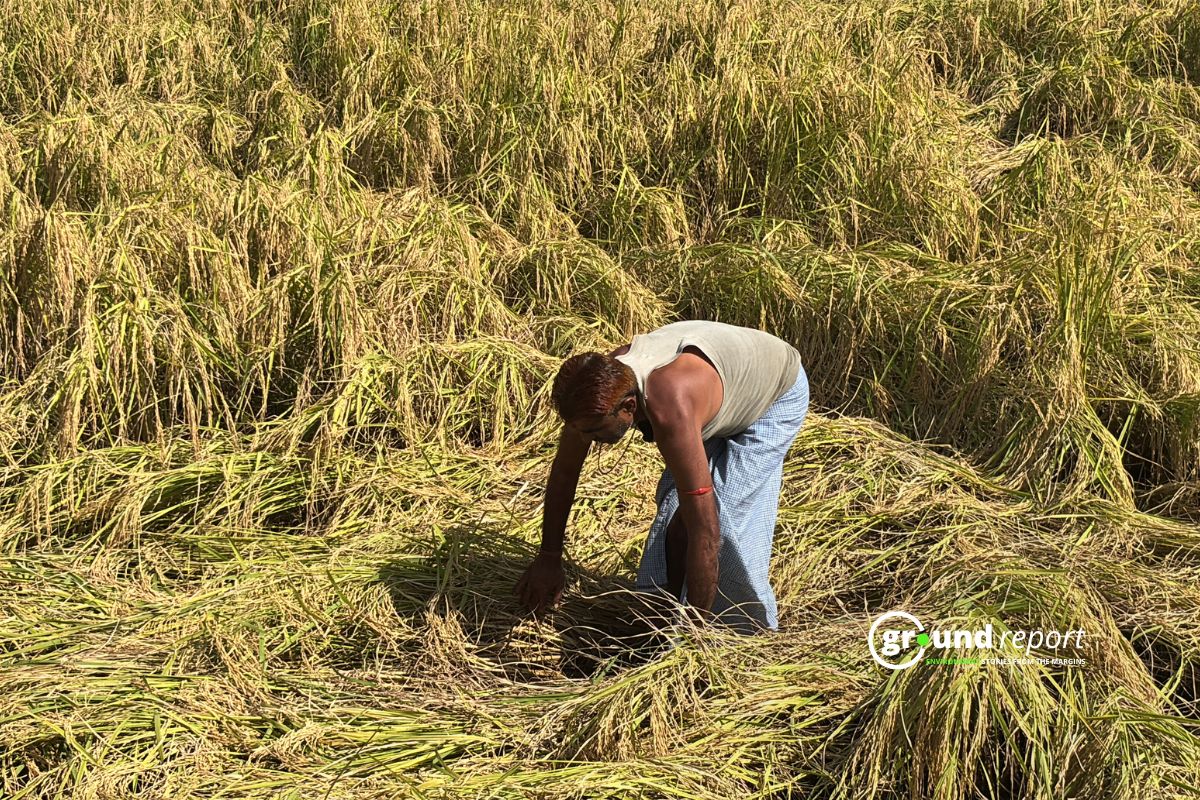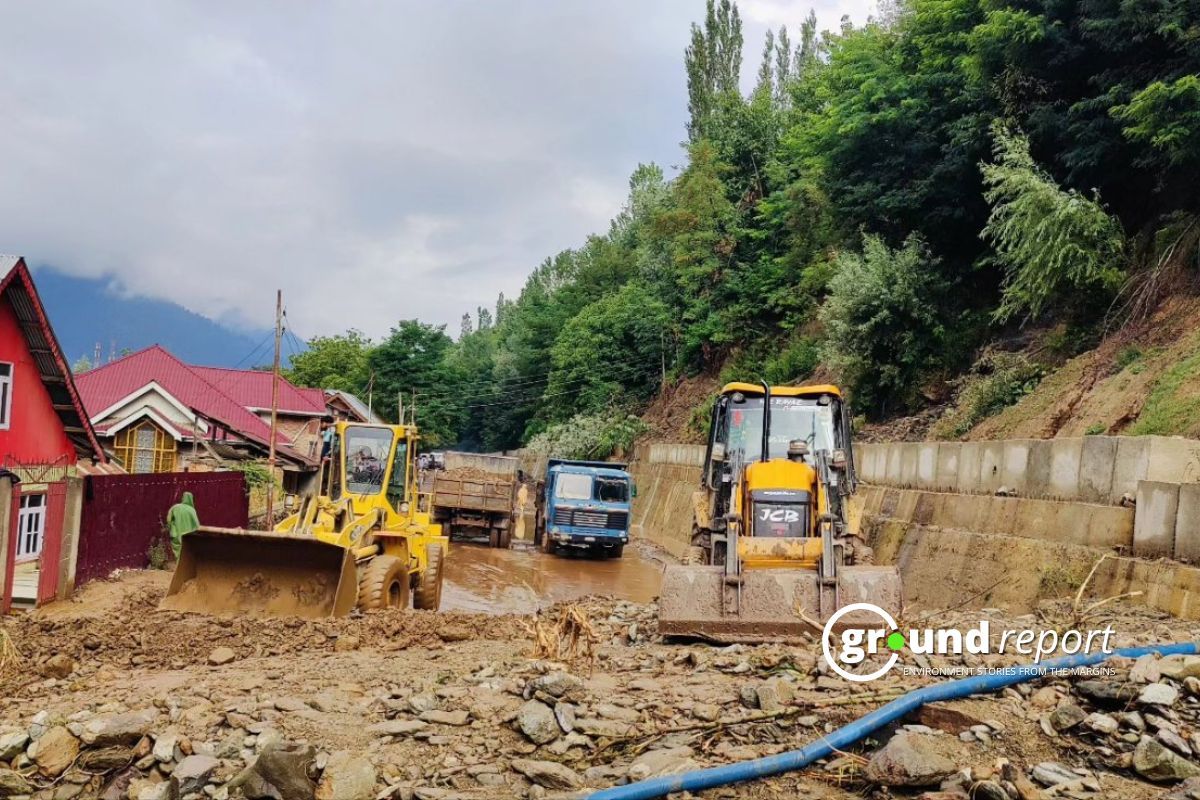In December 2021, Priyanshu and Shaleen—residents of Indore—were getting married. Instead of conventional lavish gifts and festivities for the wedding, they requested the guests donate to the conservation and revival of the Pipliyahana Lake in Indore, Madhya Pradesh. Some years back, in 2016, hundreds of residents protested against the construction of a district court complex on the edge of the lake. Kishore Kodwani, a prominent local activist, filed a petition with the National Green Tribunal (NGT) against the construction. Years later, the tribunal rejected Kodwani’s petition, stating that the proposed area was “a reservoir-like structure” and not a part of the water body.
When Groundreport visited the lake in the late summer of 2024, it barely looked like a water body. However, the district court complex stood tall in an almost completed state. There were flocks of ducks floating on the dirty water surface, navigating the weeds on the lake with precision. Situated on the Eastern Ring Road in the city, near the World Cup Four-way—Pipliyahana Lake, a prominent water body, was (is) in a state of utter dismay.

Petition, and the court complex
Kodwani, while drinking his afternoon tea, stated, “After significant construction has happened, we can’t do anything… We have to compromise.” In the petition opposing the construction, Kodwani stated that the court structure was affecting the lake’s size. He explained that instead of the complex facing the lake, now it faces the other side. However, he agreed that the solid and sewage waste might threaten the lake—if it is ever revived.
Much before the judgment, several protests were organized under the Pipliyahana Talab Bachao Samiti flag. In September 2019, a group of lawyers opposed the building as well. To determine the project’s future, the Ministry of Environment, Forests, and Climate Change dispatched an inspection committee in December 2019. Other vacant land(s) were also considered for the project, which too faced substantial protest from the farming community.
Finally, the environmental clearance order, states that “no construction is permitted within 50 meters of FRL of the catchment area of the lake ‘and should be substituted with’ No construction within 50 meters of FRL of the lake.”
“The earlier construction plan included around half of the lake, but we fought against the encroachment. Initially, it was planned to be a four-storey building, but now it is a seven-storey court to reduce the area of the building.”
Kodwani considers this to be a win, not absolute, but a win nonetheless.
Clean Water—Priyanshu’s Initiative

Priyanshu, an IIT-Bombay alum, is a co-founder and CEO of Clean Water. In 2022, he utilized the donated money through the same organization to revive the lake. Since 2022, through the organisation, Priyanshu has been working to restore this lake with sustainable solutions like floating islands, aerators, and microbial treatments. Here, they installed five floating wetlands for the lake. With an additional grant of 20 lakh rupees, they installed another eight floating plants and four floating aerators. All these products tend to revive the natural ecosystem of the lake. Priyanshu stated that all these interventions improved the water quality and condition. Eventually, this brought back the birds and ducks to the lake.

After the implementation of their interventions, they maintained the lake for a year and a half. Currently, the Indore Municipal Corporation (IMC) is responsible for the maintenance of the lake. Priyanshu said,
“There are no contracts from IMC for the maintenance of the lake. There is also no mechanism against bacterial dosing, which has led to the growth of invasive species in the lake.”
Apart from this, there is a sewage treatment plant just across the road from the lake. The plant has the responsibility to treat the grey water from the nearby areas and release it into the lake. When we visited the site, untreated water was dripping from the pipeline connected to the lake, contributing to the already devastating state of the water body.

As Priyanshu said,
“I ran a for-profit organization. I have a limited scope… There is more, which should come from the government.”
Reality check
Indore continues to bask in the glory of being the cleanest city in India. However, its water bodies struggle to revive. Every summer, like several other major Indian cities, Indore is too water-scarce. An IMC official on the condition of anonymity informed us that there is a lack of any conservation plan for Pipliyahana Lake.
“This lake is very small. It does not hold any water in the summer months, and in the winter as well, the water is not much,” they told Ground Report.
Nearly five decades ago, this lake was spread over 25 acres, which is reduced to just 12 acres today. On the subject of rejuvenation and maintenance of the lake(s), there were no clear answers. Ground Report has previously reported on the IMC’s initiative to clear the catchment areas of the major lakes in Indore and the IMC’s push for a rainwater harvesting system in residential complexes. However, as mentioned in the reportage, these interventions are limited to the outskirts of the city. Indore still supplies the costliest water to its residents.

Almost every other major city, a representation of urbanization and brutalist infrastructure, struggles to conserve its natural resources, particularly water bodies. While climate change has made the conditions worse, the problems are still at the local management level. On one hand, Kodwani took the legal route, and Priyanshu & Shaleen resorted to public participation and individual efforts. However, Indore struggles to fulfil its daily water needs, and to great disappointment, the lake’s abysmal state remains a reflection of the urban local bodies’ priorities.
Support us to keep independent environmental journalism alive in India.
Keep Reading
The costliest water from Narmada is putting a financial burden on Indore
Indore’s Ramsar site Sirpur has an STP constructed almost on the lake
Indore Reviving Historic Lakes to Combat Water Crisis, Hurdles Remain
Indore’s residential society saves Rs 5 lakh a month, through rainwater harvesting
Follow Ground Report on X, Instagram and Facebook for environmental and underreported stories from the margins. Give us feedback on our email id greport2018@gmail.com.
Don’t forget to Subscribe to our weekly newsletter, Join our community on WhatsApp, and Follow our YouTube Channel for video stories.








